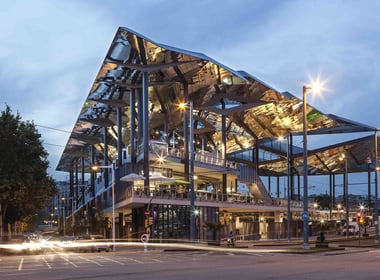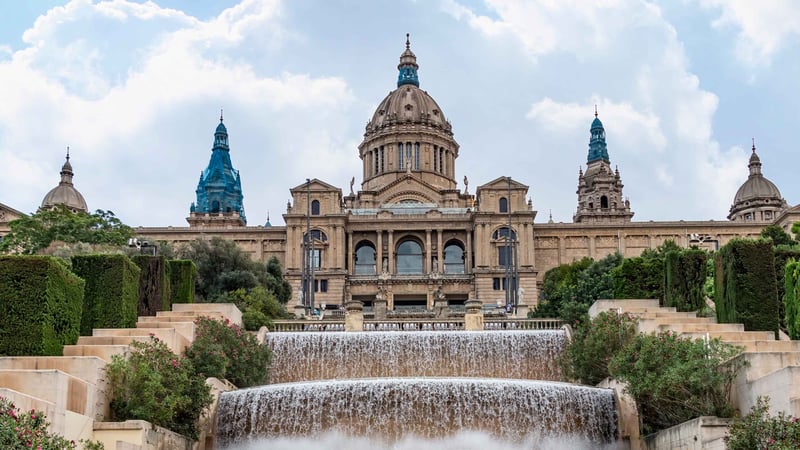İçindekiler
At the summit of Montjuic, overlooking the city with its imposing stance, MNAC (Museu Nacional d’Art de Catalunya – National Museum of Art of Catalonia) is not just a museum, but the heart of Catalan culture. Opened in 1929, this museum reveals a thousand-year artistic journey from the Romanesque period to modern art. This magnificent building, which houses the most valuable treasures of Catalan art, fascinates its visitors with its architecture and location.
The museum’s collections shed light on the art history of not only Catalonia but also the entire Iberian Peninsula. Romanesque church frescoes, Gothic altarpieces, modernist paintings and contemporary artworks come together in this museum to form a unique cultural mosaic. MNAC, where you will encounter the art of a different era at every step, is like a living encyclopedia. The panoramic view of Barcelona from the terraces of the museum is another pleasure.

Historical and Architectural Features of the Museum
The Palau Nacional, where the museum is located, was built for the 1929 Barcelona International Fair. This magnificent building by architects Eugenio Cendoya and Enric Catà is a modern interpretation of the Italian Renaissance style. One of the most striking features of the building is its central dome and the four small towers surrounding it.
The museum building has undergone many renovations over the years, with the most extensive renovation taking place in the 1990s and completed in 2004. During this renovation process, not only the building was restored, but also the exhibition areas were reorganized in accordance with modern museology.
MNAC Romanesque Art Collection
The MNAC’s most important treasure is one of the most comprehensive collections of Romanesque art in the world. The 11th to 13th century murals from Catalan churches are particularly worth seeing. The story of how these frescoes came to the museum is also quite interesting: In the 1920s, frescoes in remote churches in the Pyrenees were in danger of being stolen by smugglers. The Catalan authorities have therefore launched a massive rescue operation to protect the artifacts.

MNAC Gothic Art Department
The Gothic art section of the museum showcases the finest examples of Catalan art from the 13th to 15th centuries. The altarpieces by master artists of the period, such as Bernat Martorell and Jaume Huguet, are a living witness not only to religious art but also to the social and cultural life of medieval Catalonia. In the works exhibited in this section, you can see in detail the gold leaf and vibrant colors characteristic of the Gothic period.
Bernat Martorell’s “Saint George Altarpiece” is one of the most valuable pieces in the section. Depicting the scene of Saint George slaying the dragon, this work combines the chivalric ideals and religious beliefs of the period with great skill. With its gilded backgrounds, graceful figures and rich color palette, this altarpiece represents the pinnacle of Catalan Gothic art.
Jaume Huguet’s works provide clues about the daily life of the period. The clothes, architectural details and everyday objects he uses to depict religious scenes help us understand the lifestyle of 15th century Catalonia. The artist’s “Consecration of Saint Augustine” is a document about the religious ceremonies and clothes of the period.
MNAC Modern Art Works
In the Modern Art section, you can clearly see the development of Catalan art in the 19th and 20th centuries. Exhibiting the most outstanding examples of Modernism, Art Nouveau and avant-garde movements, this section is a living witness to the artistic transformation of Catalonia. Especially the works of pioneering artists of the period, such as Ramon Casas and Santiago Rusiñol, take visitors on a journey through time.
The works of Ramon Casas perfectly capture the social life of late 19th-century Barcelona. His famous “Ball de Tarda” (Evening Dance) painting skillfully depicts the chic cafés, modern lifestyle and changing social structure of the period. Casas’ poster works are considered to be the first examples of modern advertising.

Santiago Rusiñol’s garden paintings and landscapes are like a window to a completely different world. His works created during the “Cau Ferrat” period in Sitges are among the most beautiful examples of Catalan modernism. This section also includes sculptures by Josep Llimona, one of the most important representatives of Catalan Art Nouveau (Modernisme), and expressionist landscapes by Joaquim Mir. Each work shows how Barcelona was transformed into a center of art and culture at the end of the 19th century.
One of the most impressive aspects of the modern section is how different artistic movements intertwine. From impressionism to symbolism, modernism to the avant-garde, this transition shows the unique character of Catalan art and how it dialogues with universal art movements. Especially in the works of artists trained in Paris, it is possible to see how French influence and local traditions are blended.
MNAC Photo Collection
One of the museum’s least known but most valuable collections, the photographic archive offers a unique collection dating from the 1850s to the present day. Documenting the visual history of Catalonia, this archive brings together the works of the leading photographers of the period. Cityscapes by 19th century photographers such as Charles Clifford and Jean Laurent, architectural photographs by Adolf Mas and avant-garde works by Pere Català Pic are among the most remarkable pieces in the collection.
The narrow streets of old Barcelona, the demolished city walls, the modernist buildings, the changing fashions and lifestyles come to life in these photographs. Especially the photographs from the Spanish Civil War period are of priceless historical value. This rich archive is an indispensable resource for researchers and history buffs.

Visitor Experience and Practical Information
I recommend spending at least half a day at the MNAC. The size of the museum and the richness of the collections require a detailed visit. From the museum’s cafeteria you can enjoy the spectacular view of Barcelona and even enjoy the sunset in the evening. Especially during the Magic Fountain shows, this place becomes a unique viewing terrace.
Transportation and Visiting Hours
Getting to the museum is quite easy, you can use the Barcelona Metro Guide to get to Plaça Espanya on the L1 and L3 lines, from where you can walk or take the bus. Thanks to the escalators, getting to the top is not tiring at all.
When planning your trip to Barcelona, don’t forget to add this museum to your sightseeing list.
MNAC (Museu Nacional d'Art de Catalunya)
Website
https://www.museunacional.cat
Visiting Hours
Monday: Closed
Tuesday - Saturday: 10:00 - 18:00
Sunday: 10:00 - 15:00
Address
Palau Nacional, Parc de Montjuïc, s/n, Sants-Montjuïc, 08038 Barcelona








